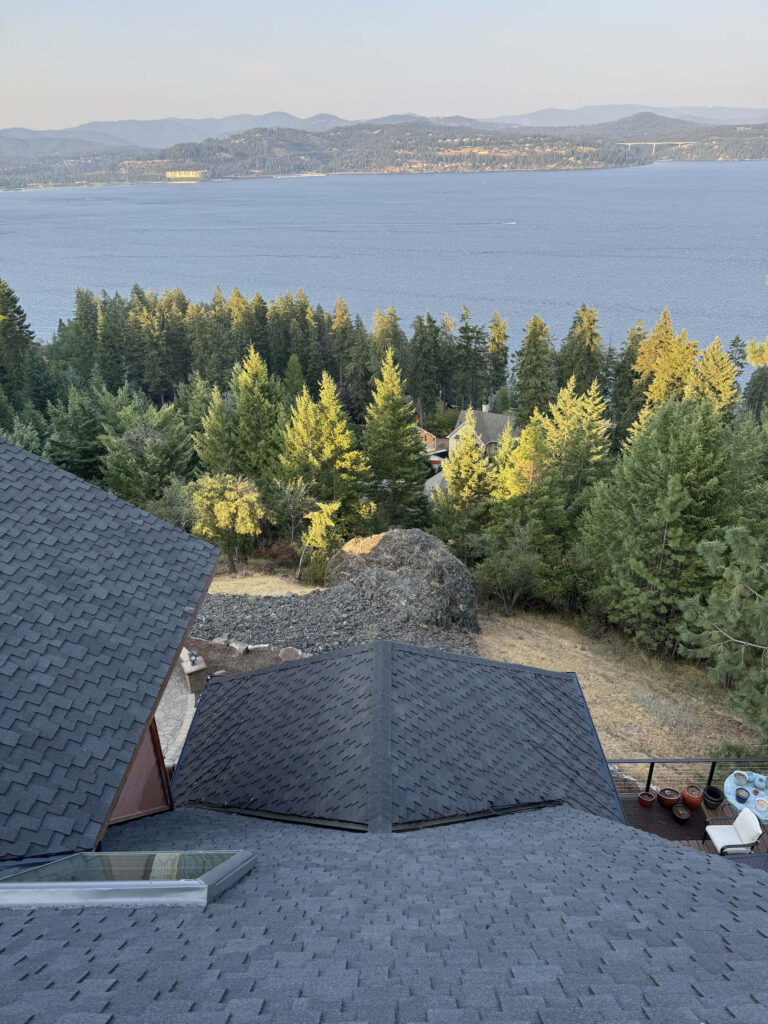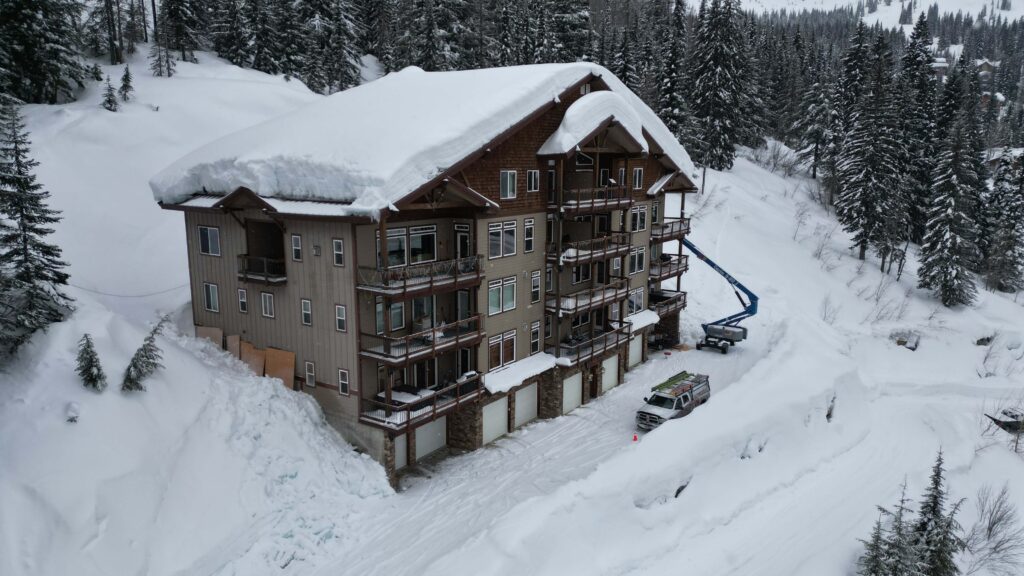Our Services
Winter Won’t Wait. Shield Your Property Today.



Winter in North Idaho is relentless, bringing heavy snow, ice dams, and freezing temperatures that can wreak havoc on your home or business. At Winter Shield, we specialize in professional heat cable installation, system automation, snow break installation, gutter solutions, and ice dam removal to keep your property safe all season long.
Proven to Work
Heat Cable Installation
The key to installing heat cable correctly is using the right methods and equipment. Most installers incorrectly use the wrong clips and equipment to secure heat cable to roof surfaces. Non-penetrating clips are essential to preserving the integrity of your roof, even if “water-proofing sealant” is used.
The truth is that all products like that weather and degrade over time, especially in our northern climate.
The only method proven to work when penetrating a roof surface is absolutely necessary, as is the case in a corrugated metal roof, is utilizing a butyl tape patch between the metal roof surface and the appropriate anodized aluminum metal clip, which is secured using self-tapping grommeted metal screws.
All of this takes more time and attention to detail than most “installers” are willing to devote since most companies that install heat cable aren’t actually heat cable installers. They are typically roofers, gutter companies, or electrical contractors who don’t have the knowledge or training to install heat cable properly so it actually protects your roof without causing new problems.
We have seen this hundreds of times and cannot overstate the importance of properly installing heat cable.
Now let’s discuss the correct way to run heat cable.
First off, the goal of heat cable is to create a melted pathway for the water to drain off, down, and away from the roof surface and structure. While winter can be beautiful and fun, it also is trying to kill your home so you have to decide where the constant precipitation is going to go year round.
That’s where heat cable is so effective because with it, the path of least resistance can be created where it will safely take the water away from your home or building. Unfortunately, most property owners and contractors forget one or more of these 3 critical steps so water may get off the roof surface, but won’t get down and away.
Solving the problem completely is key to protecting the structure from the destructive forces of water and ice (which is actually the most destructive natural force on Earth). As previously stated, Winter Shield is not the cheapest solution to the problem of ice dams, however, it is the highest quality and most thorough ice dam solutions company in North Idaho.



Smarter Systems, Lower Energy Costs
System Automation & Controls


Want to know a secret? The largest and sometimes surprising cost associated with heat cable isn’t the initial cost, it’s the cost of running the system, i.e. your electric bill.
Knowing that, there are a few ways we help our customers mitigate the cost of running their systems.
First, we only apply the amount of cable that is absolutely necessary. Every foot counts and we painstakingly design each system to be as efficient as possible, including taking into consideration the electrical upgrade cost associated with running new electrical circuits for your system.
Secondly, we incorporate into each design as much automation and “smart” features as possible to decrease the amount of electricity consumed by your heat cable system. To start, the cable we use is called “self-regulated” because the cable actually reduces or increases the amount of electricity it uses based on the temperature. This means that when it’s hovering around 32º outside, the cable is drawing less electricity than when it drops to 10º or 0º, where it needs more electricity to maintain its operating temperature.
In addition, control units can be added to the systems that use temperature and precipitation censors to turn the power completely off when the conditions call for it.
Year-Round Protection
Snow Break Installation
Ok, this is going to get a bit nerdy so consider yourself warned. With the exception of ice dams, we have found that the most misunderstood component to a roof system here in North Idaho is the proper application and placement of snow breaks, a.k.a snow retention.
Often we will see snow breaks installed on roofs with uniform and linear spacing from just above the eave line up to the ridge of a roof pitch. This is logical if you are a civil engineer, however, the problem is that snow does not compress in a linear fashion. According to the well documented and observed force, known as the compression rate of snow, a uniformly spaced placement of snow breaks is actually not the correct way to install snow breaks.
The problem lies with how snow on a slanted plain compacts in the real world. This is the factor that should determine where snow breaks are actually placed on a roof. The answer, for the curious mind still reading, is the lower third of the roof is where snow retention needs to be placed. The type and quantity will depend on the type of roof, average annual snowfall in that specific location, and the goals of the property owner when it comes to controlling snow on a structure.
Equally important to the placement of snow breaks is the method of attaching them. This is where so many contractors get it wrong. The force placed on snow breaks can be extreme so securing it to the roof in a structural manner is required. Penetrating the roof surface is required in some circumstances such as corrugated metal roofs, but ONLY with the use of butyl tape patches and the appropriate metal clips specifically designed for this application.
We cannot overstate the importance of doing this properly.


Durable Water Control
Gutter Installation


Gutters are an essential component of a properly functioning roof system when ice dams are an issue.
There are some exceptions, but generally speaking when snow and ice are melted into water using heat cable, the flow of water needs to be controlled and directed or you will just relocate the problem of ice buildup further down your structure.
To ensure the water continues moving off, down, and away from your structure, we cable the gutters and downspouts downhill from the cabled section of roof. Regardless of whether or not you have gutter guards installed, we are able to cable the gutters in an effective manner so that the water continues to flow where we need it to go. While gutters are typically essential, they do present a serious challenge when it comes to installing heat cable since gutters are made of sheet metal and usually have dozens if not hundreds of razor sharp edges and screws we have to carefully navigate with the cable without cutting it even once.
This is where having a professional installer with all of the necessary tools and equipment is critical to ensuring the longevity of the cable you invest in as well as knowing you can rely on the system that is supposed to protect your property from ice dams. Installing cable in gutters without the correct cable guards and specialized pieces will inevitably result in either complete failure of your system or at least a decreased lifespan which is unnecessarily costly and hazardous.
If your property needs gutters, we can take care of professionally installing them and cabling them properly so your property is effectively protected against ice dams.
Emergency Ice Dam Removal When You Need It Most
Ice Dam Removal
Not everyone who purchases or builds a structure up here knows if they will deal with ice dams, so if winter surprises you with an ice dam on your property, removing it safely will be one of your top priorities. Sadly, the typical North Idaho solution is to climb up on a snow and ice covered roof with a hammer or hatchet and hack away at the ice until the water can get off your roof. While that’s an option, it’s certainly not one we recommend for many, many reasons.
The only safe and effective way to remove ice dams is using a commercial steam machine like the one Winter Shield uses from the company American Pressure. Known as the Arctic Steamer, this highly specialized piece of equipment produces 295℉ steam at around 395 PSI, which is considered high temperature and low pressure. Combined with a patented nozzle, the superheated steam cuts through ice with extreme prejudice without harming your roof surface at all.
BE AWARE, we are not using a heated pressure washer! Some contractors pretend to have the right equipment, but in reality what they possess will destroy your roof in short order. If the wand they are holding has a trigger, fire them immediately! A true steam machine is a kerosene guzzling, steam producing jet engine with no on/off trigger. It is complicated to use, requires precise setup and shut down procedures, uses hazardous chemicals to run(which never leave the machine) and are around $10k with everything needed to run them. At the time of this article, there are only 4 in all of North Idaho and Winter Shield is the only heat cable and ice dam specialist to own and operate one.
We can cut through ice dams from a few inches, to more than 3 feet thick. The correct and most efficient way to remove ice is to cut the dam into blocks and then to cut them off the roof so they slide off in chunks. Melting the entire dam is unnecessary and would waste your money as the customer, be aware of this, especially from inexperienced contractors. After the ice dam is removed, we can install heat cable to the roof so your structure will be protected for the remainder of winter and for seasons to come.


